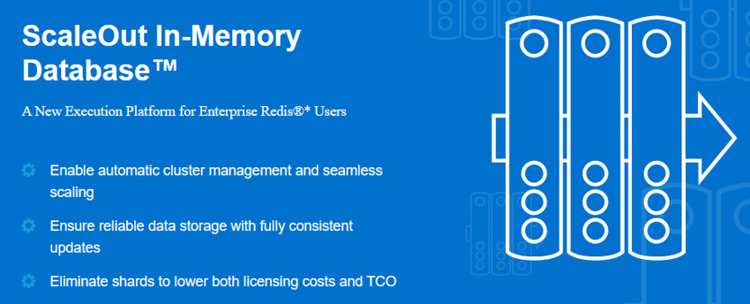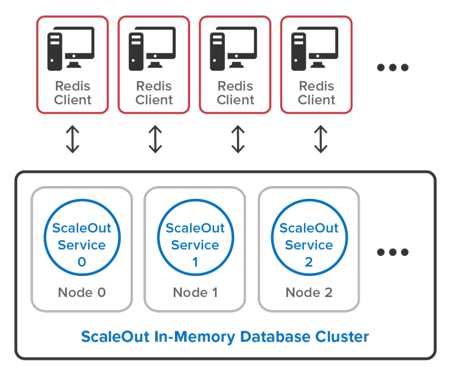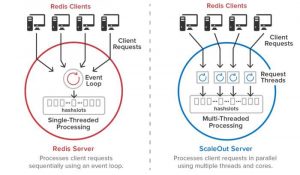ScaleOut Software In-Memory Database With Support for Redis Clients
Creates breakthrough in scaling and ease of use for users.
This is a Press Release edited by StorageNewsletter.com on June 30, 2022 at 2:01 pmScaleOut Software introduces In-Memory Database with support for Redis clients as a full production release.
Redis Ltd.’ clients can connect to a cluster of ScaleOut servers to run Redis commands and improve their ease of use, scaling, and automated data recovery. Redis users can also simultaneously backup and restore all cluster nodes with a single command. Designed for use in enterprise deployments, these combined capabilities maximize cost savings and computing resources, and they eliminate key limitations of commercial Redis products.
The In-Memory Database incorporates open-source Redis version 6.2.5 code to process Redis commands, and it offers the flexibility to run on either Linux or Windows servers. This production release supports all Redis data structures (strings, sets, sorted sets, lists, hashes, geospatial, hyperloglog, and streams), as well as transactions, publish/subscribe commands, and blocking commands. Not supported in this release are LUA scripting, modules, and AOF persistence.
Unlike open-source Redis, In-Memory Database implements fully consistent updates to stored data. In addition, its native APIs run alongside Redis commands and include advanced features, such as data-parallel computing, streaming analytics, and coherent, wide-area data replication, which are not available on open-source Redis clusters.
Key capabilities include:
-
Actual Redis Open-Source Code: In-Memory Database has integrated Redis version 6.2.5 into its software architecture to manage stored data as a single Redis database and to run all Redis commands. Results produced by Redis commands are identical to those from a Redis open-source server.
-
Simplified and enhanced cluster management: In-Memory Database automatically manages all cluster operations, including hashslot creation, load-balancing, data replication, failure detection, and recovery. It distributes Redis hashslots across a server cluster and redistributes them as servers are added or removed. It also uses fully coherent cluster membership to detect server or network outages, rebalance workloads on surviving servers, and create additional replicas to maintain redundancy of stored data.
-
Advanced client management: In-Memory Database simplifies client applications by always providing clients with accurate information about the location of hashslots. It automatically stalls client commands while hashslots are in motion to avoid client-side exceptions and ensure that clients always see a cluster view.
-
Multi-threaded architecture: In-Memory Database’s multi-threaded architecture automatically uses all processing cores to accelerate the execution of Redis commands. This eliminates the single-threaded bottleneck created by Redis’ event-loop architecture and avoids the complexity of deploying additional ‘shards’ to boost throughput on each server.
“We are excited to deliver the full production version of our clustered server platform for Redis with In-Memory Database,” said Dr. William Bain, CEO and founder, ScaleOut Software. “Enterprise Redis users can now take advantage of In-Memory Database to dramatically simplify their cluster management, enable reliable data storage, and reduce their total cost of ownership.”
Benefits of ScaleOut In-Memory Database for Redis
In-Memory Database offers these key benefits for Redis users:
-
Battle-tested software architecture: Developed over more than 19 years and proven in hundreds of mission-critical deployments, In-Memory Database’s software technology was designed for transparent throughput scaling with integrated high availability and ease of use. In contrast, Redis was conceived as a single-server, data structure store and later enhanced to add clustering features.
-
Data consistency: Unlike Redis clusters, which employ an eventual consistency model for updating stored data, In-Memory Database implements full data consistency using a patented, quorum-based algorithm. This ensures that the caching cluster never serves stale data after a server fails and matches the needs of business-critical operations.
-
Transparent throughput scaling: By employing a multi-threaded software architecture to execute Redis commands, In-Memory Database automatically scales its performance to take advantage of the processing cores on each server. By comparison, Redis uses a single-threaded event loop and requires that multiple “shards” be deployed on each server to increase processing throughput.

















 Subscribe to our free daily newsletter
Subscribe to our free daily newsletter


